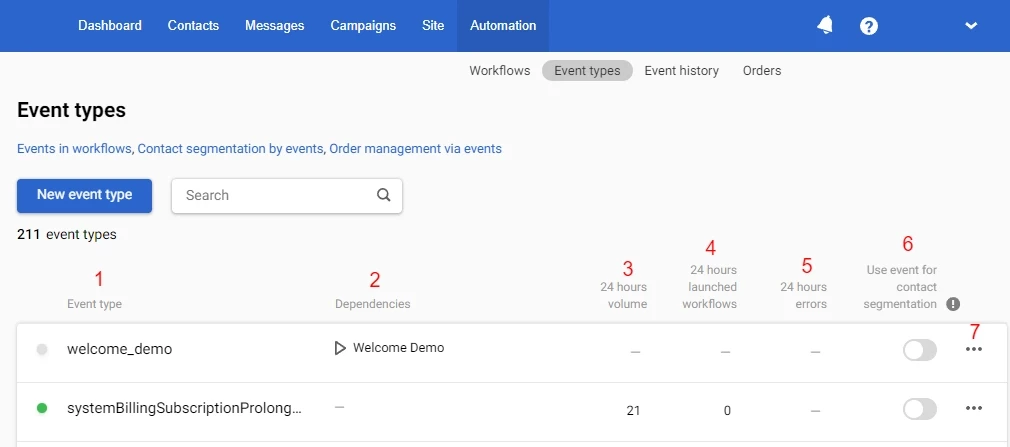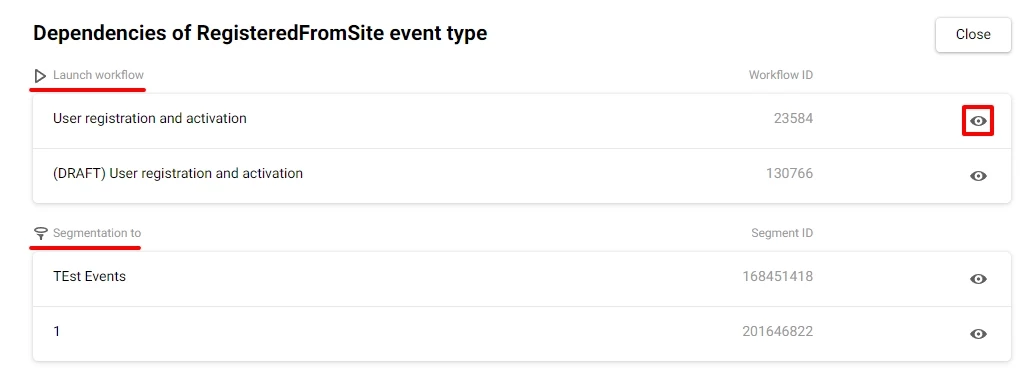First steps
User Data
- Responsive Email Editor Review
- Designing your email
- Creating Synchronized Modules
- Setting Up Responsive Email Design
- Setting Up Smart Containers
- Creating a Gmail Promotions Annotation
- Adding The Rollover Effect
- Adding Anchor Links
- Module Library
- Adding a Table to an Email
- Adding Custom Fonts
- Creating CTA Button
- Working with Images
- Creating Timer
- Using AI in the Email Editor
Omnichannel
- Setting Up Widgets for Your Site
- Widget Calling
- Setting Up Locations for the Widget Calling Rules
- Storing data from widgets to contact fields
- Using Annoyance Safeguard
- Actions After Form Submission
- Replacing Double Opt-In System Workflow
- Using Yespo Extension for Google Chrome
- Creating Pop-ups via Google Tag Manager or WordPress
- Sending Yespo Widget Events to Google Analytics
- Using A/B Tests for Widgets
Automation
- Building and Editing Workflows
- Configuring Workflow Start/Stop Conditions
- Start Block
- Popular Blocks
- Message Blocks
- Contact Blocks
- Conditions Blocks
- Other Blocks
- Message to Segment Blocks
- Time Blocks
- Setting Up Allowed Send Time
- Using Workflow Launch History
- Webhook Workflows
- Workflow Troubleshooting
- Double Opt-In
- Welcome Сampaign
- Welcome Series Segmented by Category
- Launching a Workflow After a Contact Import
- Regular Workflow for a Segment
- Birthday Campaign
- Linking Workflow to the Button
- Using Variables from Order in Workflow
- Collecting Order Feedback
- Customer Reactivation
- Sending Extra Campaigns
- Sending Campaign to Those Who Did Not Open the Previous One
Personalization
Analytics
- Email Campaign Report
- Web Push Campaign Report
- Viber Campaign Report
- Mobile Push Campaign Report
- App Inbox Campaign Report
- In-App Report
- Widget Report
- Triggered Campaign Report
- AMP Campaign Report
- SMS Campaign Report
- Multilingual Campaign Report
- Setting up UTM Tags
- Revenue from Campaigns
- Tracking Campaign Performance in Google Analytics 4
- Message Analytics
Multilanguage Campaigns
Events and Behaviour Tracking
Recommendations
API
Security and Compliance
Integration
Events
An event is a signal about changes in the user profile. Events can be generated by changes in the profile field values, by user activity or inactivity (on the website, in campaigns), or by pre-configured API requests. They are used to launch triggered campaigns i. e. serve as triggers. As soon as the system receives a signal about a certain event (for example, a click or added product), it automatically launches the corresponding workflow.
Events can be generated both in the system and in external systems such as CRM or CMS. In the second case, events are sent to our platform via API.
Event Categories
There are 6 event categories in our system:

-
Click: generated by a click on the link in the email assigned to the event. This is a default category. Read more on how to assign a workflow to a CTA.
-
Subscribe/Unsubscribe: generated by a click on Subscribe/Unsubscribe in the subscription form or on the unsubscribe page. This is a service category that is configured by our support team when they create the corresponding form.
-
RFM: generated when subscribers migrate between segments depending on their activity. The category is chosen when you set up triggers based on RFM analysis (R – the time since the last activity (purchase/open); F – the frequency of purchases or opens; M – money customers spent). For example, you can set up a trigger when users move from the segment “bought 3 months ago” to the segment “bought 6 months ago” category, and send corresponding reactivation campaigns in time.
-
Import: a default category that is used to launch a workflow after contact import. You can also create other events in the Import category on your own. For example, import of male contacts only can launch one workflow, and import of female contacts only – another.
-
Notification: a service category that is automatically created after trigger failure alerts settings.
-
Other: generated by all custom events that can be created manually or sent via API, for example, website registration, adds to cart, etc.
Events from the categories Link and Other are most common, events from RFM and Import are less common. To facilitate the automation process, the following most often used events are available in the system by default:
-
Confirmed subscription (Click);
-
Import of new contacts (Import);
-
Filled form (Subscribe/Unsubscribe).
Creating an Event Type
You can create events in two ways:
- Automatically (via API, after setting up the launch conditions for regular workflow and workflow based on changes in the contact's field)
- Manually.
The event sent via API is automatically registered in the Other category. Read more on API integration.
To create an event manually:
1. Go to Automation → Event types and click New event type.

2. Fill in Name (required).
3. Fill in Key (required). A key is a unique event identifier that is registered in the system. You can fill in any text in Latin, with numbers allowed, for example, click, sale1, etc.
Note
The main requirement is that the key should be unique for every event.

4. In Category, select the necessary event category.

5. If you're subscribed to Segmentation by user events, enable Use event for contact segmentation. Segmentation primarily applies to user-generated events sent via API.

Note
To subscribe, please contact our sales team sales@yespo.io
6. Enable Validate parameters.

If the option is enabled, the system only accepts an event whose structure complies with the validation rules.
More about Validating Event parameters >
7. Click Add.
After this, a new event type appears in the Event types list.

Launching a Triggered Campaign on Event
Creation will differ depending on the event category, but the main steps are as follows:
Step 1. Registration in the System
At this stage, you need to create an event in Yespo or provide integration with the system to send custom events via the API (see “Creating an event”).
Create an event manually or send it via API. All created events are displayed in Automation → Event types.

Step 2. Create a Workflow
Create a workflow that will be launched by the created event. For example:
- click in the message (Click);
- subscription (Subscribe/Unsubscribe);
- import of new contacts (Import);
- migration of subscribers from active to passive (RFM);
- website and app activity (Other, Subscription, View);
- order (initialized, in progress, delivered, canceled).
- Go to Automation → Workflows and click New workflow.

-
Enter the workflow name and description (optionally).
-
Build the workflow by dragging the necessary blocks and connecting them.
This is an example of the workflow that will be triggered by a click on the Learn more button in the message. All contacts that have clicked this button will be added to a separate segment Opened, and will receive an additional message with details of the previous offer.

Note
To extract the data out of order and pass it to the message, use Get order block
Step 3. Link the Event to the Workflow
- Go to Automation → Workflows and click Trigger configuration.

- In pop-up window activate Start configuration switcher and select the event.
- Click the Event-based tab and select one of the process unique events option:
- Each time: to launch the workflow each time when receiving the event. For example, choose this option for the triggered workflow Order. Each time your customer makes an order, they will receive a corresponding message (for example, confirmation). If they make 3 separate orders per day, they will receive 3 messages.
- Once: to launch the workflow only once regardless of the number of events sent by the same contact. For example, choose this option for a welcome series after the first purchase: no matter how many orders the customer makes, they will receive only one welcome series.
- Once in every ____ hours/days/weeks/months: to launch the workflow once within a given period of time. For example, choose once in 1 hour for abandoned carts. If the same customer abandons cart 3 times in an hour, the workflow will process only one event and send only one message.

- Click Apply.
The event will appear in Launch conditions of the configured workflow. The workflow will appear in Linked workflow of the assigned event.

Step 4. Launch the Workflow
Click the Activate icon and confirm your action.

The status of the workflow will change to active.

After you link the event to the workflow, this event will trigger the workflow launch for the contact whose information (email address, phone number, token) is sent in the event. Contact information is sent in an integral part of the event.
{ "params": [ { "name": "ContactId", "value": "22222" }, { "name": "EmailAddress", "value": "youremail@gmail.com" } ] }
Event Type Management
Go to Automation → Event types to view available event types.

Activity Statuses
Event types can be Active or Inactive depending on the activity status in the system.
To sort events by activity, click on the tab:
- All statuses
- Active
- Inactive

Event Type Dependencies
Event type dependencies represent the relation between the event type and a workflow or dynamic segment.
To filter event types by dependencies, select the tab:
- All dependencies
- Launch workflow
- Stop workflow
- Enabled segmentation
- Without dependencies

List of Event Types

The general list displays the following information:
1. Event type
Event types created for regular workflows and workflows based on contact field changes contain:
-
Segment name, segment ID.
-
Contact field name, contact field ID.

The numbers in the event type name are the IDs of the dynamic segment contact field.
2. Dependencies
The Dependencies column displays workflows and dynamic segments related to event types. An empty field means that the event type has no dependencies.

Note
One event type can have multiple related workflows and dynamic segments. In this case, dependencies are grouped, and their quantity is displayed.
Clicking on a dependency opens the Dependencies of event type window with detailed information about each related workflow and dynamic segment.

To view and edit related objects, click on the eye icon.
3. 24 hours volume: number of event types in the last 24 hours.
4. 24 hours launched workflows: number of workflows launched for this event in the last 24 hours.
5. 24 hours errors: number of workflow errors in the last 24 hours.
6. Use event for contact segmentation (switch to activate/deactivate).
7. Additional management options.

Clicking on the three dots in the event type field reveals a menu with options such as:
-
Event history: go to the Event history section.

-
Validate parameters: configure validation rules.

-
Structure preview: preview the structure of the event type, with parameters that can be copied.

The Structure preview option is available for enabled segmentation events.
Note
When transmitting new parameters, they will add to the event parameter structure, while the existing ones will remain unchanged.
-
Delete: delete the event type.
To search for event types in the general list, use the search bar by event name.

Event History
You can view the events sent to the system in Automation → Event history.

If no events have been sent, the tab will be empty.
You can track events sent to Yespo, filter them by name and time, and search by key.
Event type, its key, linked workflow, the contact found (if event segmentation is used), and time when the event is registered, are displayed in the general list of events.

Click the event to see its parameters.

This information will allow you to monitor the workflow in progress.
If you have any questions, please contact to support@yespo.io